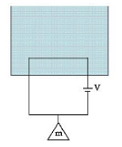A massless square loop, of wire of resistance $10\, \Omega$, supporting a mass of $1 \, g$, hangs vertically with one of its sides in a uniform magnetic field of $10^3 G$, directed outwards in the shaded region A de voltage $V$ is applied to the loop For what value of $V$, the magnetic force will exactly balance the weight of the supporting mass of $1 g$ ?(If sides of the loop $=10 \, cm , g =10\, ms ^{-2}$ )


- $\frac{1}{10} V$
- $1 V$
- $100 V$ $
- 10 V$
The Correct Option is D
Solution and Explanation
The relationship between the charges and radii is given by:
\[ \frac{1}{4 \pi \epsilon_0} \cdot \frac{Q_1'}{R} = \frac{1}{4 \pi \epsilon_0} \cdot \frac{Q_2'}{2R} \]
Simplifying, we find:
\[ Q_2' = 2Q_1' \]
Using the charge conservation equation:
\[ Q_1' + Q_2' = Q_1 + Q_2 \]
Substitute \(Q_2' = 2Q_1'\):
\[ Q_1' + 2Q_1' = 20 \pi R^2 \sigma \]
\[ 3Q_1' = 20 \pi R^2 \sigma \]
\[ Q_1' = \frac{20 \pi R^2 \sigma}{3} \]
Substitute \(Q_2' = 2Q_1'\):
\[ Q_2' = \frac{40 \pi R^2 \sigma}{3} \]
The surface charge densities are related by:
\[ \sigma' = \frac{Q_2'}{4 \pi (2R)^2} \]
\[ \sigma' = \frac{\frac{40 \pi R^2 \sigma}{3}}{16 \pi R^2} \]
\[ \sigma' = \frac{40}{3} \cdot \frac{1}{16} \cdot \sigma \]
\[ \sigma' = \frac{5}{6} \cdot \sigma \]
Electromagnetic Force and Voltage:
The force on a current-carrying conductor in a magnetic field is given by:
\[ F_m = ILB \]
Equating with gravitational force \(F_m = mg\):
\[ ILB = mg \]
Substitute \(I = \frac{V}{R}\):
\[ \left(\frac{V}{R}\right)LB = mg \]
Solve for \(V\):
\[ V = \frac{mgR}{LB} \]
Substitute the given values \(m = 1 \times 10^{-3} \ \text{kg}\), \(g = 10 \ \text{m/s}^2\), \(R = 10 \ \Omega\), \(L = 0.1 \ \text{m}\), and \(B = 10^{-3} \ \text{T}\):
\[ V = \frac{(1 \times 10^{-3})(10)(10)}{(0.1)(10^{-3})} \]
\[ V = 10 \ \text{V} \]
Final Answer:
Voltage \(V = 10 \ \text{V}\)
Top Questions on Electromagnetic induction
- You are required to design an air-filled solenoid of inductance 0.016 H having a length 0.81 m and radius 0.02 m. The number of turns in the solenoid should be:
- CBSE CLASS XII - 2025
- Physics
- Electromagnetic induction
- A rectangular metallic loop is moving out of a uniform magnetic field region to a field-free region with a constant speed. When the loop is partially inside the magnetic field, the plot of the magnitude of the induced emf \( (\varepsilon) \) with time \( (t) \) is given by: \includegraphics[width=1\linewidth]{3.png}
- JEE Main - 2025
- Physics
- Electromagnetic induction
- A conducting bar moves on two conducting rails as shown in the figure. A constant magnetic field \( B \) exists into the page. The bar starts to move from the vertex at time \( t = 0 \) with a constant velocity. If the induced EMF is \( E \propto t^n \), then the value of \( n \) is ________________________.

- JEE Main - 2025
- Physics
- Electromagnetic induction
- Consider two long co-axial solenoids \( S_1 \) and \( S_2 \), each of length \( l \) (\( l \gg r_2 \)) and radius \( r_1 \) and \( r_2 \) (\( r_2>r_1 \)). The number of turns per unit length are \( n_1 \) and \( n_2 \), respectively. Derive an expression for mutual inductance \( M_{12} \) of solenoid \( S_1 \) with respect to solenoid \( S_2 \). Show that \( M_{21} = M_{12} \).
- CBSE CLASS XII - 2025
- Physics
- Electromagnetic induction
- The ratio of the number of turns of the primary to the secondary coils in an ideal transformer is 20:1. If 240 V AC is applied from a source to the primary coil of the transformer and a 6.0 \( \Omega \) resistor is connected across the output terminals, then the current drawn by the transformer from the source will be:
- CBSE CLASS XII - 2025
- Physics
- Electromagnetic induction
Questions Asked in JEE Main exam
The integral is given by:
\[ 80 \int_{0}^{\frac{\pi}{4}} \frac{\sin\theta + \cos\theta}{9 + 16 \sin 2\theta} d\theta \]
is equals to?
- JEE Main - 2025
- Integration
- Let \( A(6,8) \), \( B(10\cos\alpha, -10\sin\alpha) \), and \( C(-10\sin\alpha, 10\cos\alpha) \) be the vertices of a triangle. If \( L(a,9) \) and \( G(h,k) \) be its orthocenter and centroid respectively, then \( 5a - 3h + 6k + 100\sin2\alpha \) is equal to _____ .
- JEE Main - 2025
- Coordinate Geometry
- If \[ \sum_{r=1}^{30} r^2 \left( \binom{30}{r} \right)^2 = \alpha \times 2^{29}, \] then \( \alpha \) is equal to _________.
- JEE Main - 2025
- Combinatorics
The IUPAC name of the following compound is:

- JEE Main - 2025
- Nomenclature Of Organic Compounds
Which of the following is the correct IUPAC name of the given organic compound (X)?
The structure of compound $ X $ is as follows:$ \text{H}_3\text{C} - \text{CH}_3 - \text{CH} = \text{CH} - \text{H} - \text{Br} $
- JEE Main - 2025
- Nomenclature Of Organic Compounds
Concepts Used:
Electromagnetic Induction
Electromagnetic Induction is a current produced by the voltage production due to a changing magnetic field. This happens in one of the two conditions:-
- When we place the conductor in a changing magnetic field.
- When the conductor constantly moves in a stationary field.
Formula:
The electromagnetic induction is mathematically represented as:-
e=N × d∅.dt
Where
- e = induced voltage
- N = number of turns in the coil
- Φ = Magnetic flux (This is the amount of magnetic field present on the surface)
- t = time
Applications of Electromagnetic Induction
- Electromagnetic induction in AC generator
- Electrical Transformers
- Magnetic Flow Meter